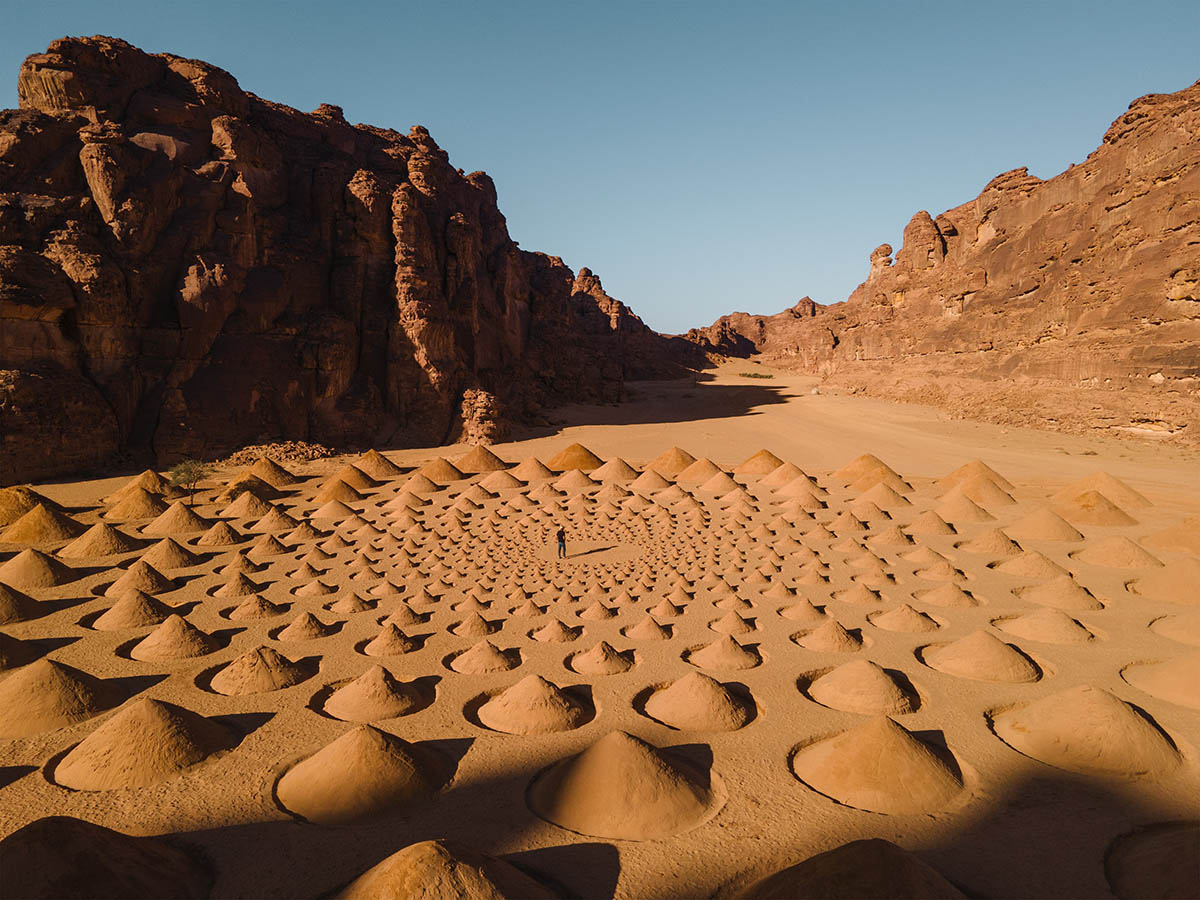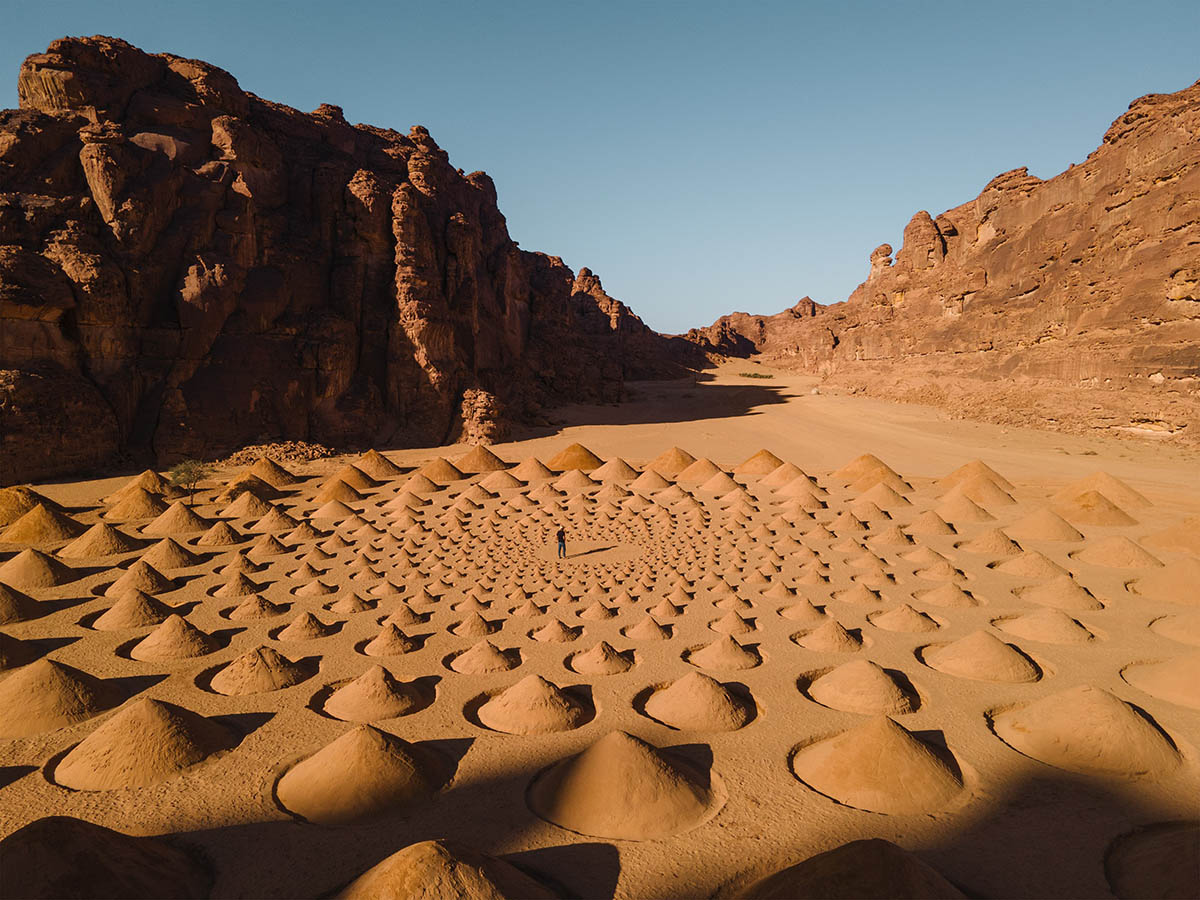Submitted by WA Contents
Desert X AlUla explores ideas of mirage and oasis with 15 installations in Saudi Arabian desert
Saudi Arabia Architecture News - Feb 15, 2022 - 16:33 4611 views

The 2022 edition of Desert X AlUla has featured 15 site-specific work from Saudi and the world artists, which is taking place from February 11 to March 30, 2022 amidst the majestic Alula desert in Saudi Arabia.
Desert X AlUla is the Saudi Arabian iteration of the Desert X, produced by The Desert Biennial, a not-for-profit 501(c)(3) charitable organization founded in California. It was conceived to produce recurring international contemporary art exhibitions that activate desert locations through site-specific installations by acclaimed international artists.
The 2022 theme of the Desert X AlUla is "Sarab" and is presented under the curatorial vision of independent curator and art historian Reem Fadda, Jeddah-based curator Raneem Farsi and art curator Neville Wakefield.
This year's theme explores ideas of mirage and oasis, both intrinsic to desert history and culture, that have taken on complex worldwide significance over time. The curators invited the Saudi and the world artists to consider these ancient concepts.
Participating artists have responded with new works, addressing dreams, camouflage, fiction, dis/appearance, extraction, illusion and myth, while also examining the dichotomy between the natural and man-made worlds.
"The exhibition connotes the incomprehensible beauty and abundance of nature in its most bereft state – the desert – and humans’ obsessive desire to capture and control it"
Participating artists include Saudi Arabian visual artist Shadia Alem, Ghanaian artist Serge Attukwei Clottey, London-based artists Shezad Dawood, Canadian visual artist Stephanie Deumer, Palestinian-Saudi artist Dana Awartani, Polish installation artist Monika Sosnowska, American artist Jim Denevan.
Desert X AlUla is a collaboration between Desert X and the Royal Commission for AlUla (RCU) established to advance new cultural dialogue through art.
The first site-responsive exhibition of its kind in Saudi Arabia, it fosters dialogue and exchange between artists, curators and international and local communities, shaped by a curatorial vision that takes the desert as its inspiration.
Building on the legacy of Desert X, which takes place in California’s Coachella Valley, Desert X AlUla draws on principles of land art, offering a profound opportunity to experience art on a monumental scale in dialogue with nature.

Work of Abdullah AlOthman. Image © Lance Gerber
In the installation above, Abdullah AlOthman’s piece references theories of light refraction rooting back to the early days of desert civilization and culture, with stainless steel plinths that interact with the light and create a radiant space that seeks to manifest the experience of capturing the mirage for the first time.
"The desert concepts of mirage and oasis have long been tied to ideas of survival, perseverance, desire and wealth. The oasis pertains to ideas of finding prosperity or heaven, while the mirage is a universal symbol of the mysteries of imagination and reality," said Reem Fadda, curatorial advisor to Desert X AlUla 2022.
"They also connote the incomprehensible beauty and abundance of nature in its most bereft state – the desert – and humans’ obsessive desire to capture and control it."
"Under the theme of ‘Sarab’, the artists presented in the exhibition – all of whom have spent time in the AlUla region – have developed ambitious and strikingly innovative, site-specific responses, all of which address profound issues, that emerge from the local context but also resonate with audiences the world-over," Fadda added.

Work of Shezad Dawood. Image © Lance Gerber
In the installation above, Shezad Dawood’s work explores ideas of deep time and the geo-biological relationship between the desert floor and nearby Red Sea through a pair of coral-like forms whose temperature-sensitive surfaces reflect the effects of climate change and mankind’s continuing struggle to find a sustainable relationship with a rapidly changing ecosystem.
"The exhibition explores the idea of the desert as a place of cultural interaction"
"Alula has always been at the crossroads of trade and culture. Its landscape and history have and continue to draw people from across the globe. In captivating the imagination of artists and travelers alike, AlUla presents itself as the perfect site for an exhibition that explores the idea of the desert as a place of cultural interaction, dialogue and exchange," said Neville Wakefield, co-artistic director of Desert X AlUla.
"The first edition of Desert X AlUla in 2020 proved how much there is for artists and audiences from different parts of the world to learn from one another. Artists are often leaders in these conversations and so it is particularly exciting for Desert X AlUla to have such a significant role in the region’s many programs of cultural transformation," Wakefield added.

Work of Alicja Kwade. Image © Lance Gerber
For instance, Polish-German contemporary visual artist Alicja Kwade’s architectural structures reflect and frame the natural artefacts she encountered on the desert floor, which she rearranged and supplemented to create constantly changing perspectives that strike the fine line between reality and illusion.
"Art has the power to transform societies, cities, and perspectives"
"As a powerful form of self-expression, art has the power to transform societies, cities, and perspectives. Everyone is hungry for the best in contemporary art – and Desert X AlUla is feeding that appetite in an unprecedented way," said Raneem Farsi, co-artistic director of Desert X AlUla.
"Having worked for many years on the development and representation of the Saudi art scene, I can see that today Saudi artists are getting more attention and opportunities than ever before, both locally and internationally. Desert X AlUla plays a very important part in a vast wave of art and culture initiatives that is shaping the ecosystem for creativity in Saudi Arabia," Farsi added.

Work of Ayman Zedani. Image © Lance Gerber
Saudi Arabian artist Ayman Zedani created a soundscape installation in a rocky cavern which comprises horizontal sculptural wires and an audio projection of music, voices and footsteps, creating a cacophony of sounds that add to the chimes of nature.
 Work of Claudia Comte. Image © Lance Gerber
Work of Claudia Comte. Image © Lance Gerber
Swiss artist Claudia Comte creates an installation that features a progression of walls imposing their architectural presence within the natural order of the AlUla canyons, with each carrying a section of a larger algorithmic pattern relating to the waveforms that shape the sound and surface of the desert.

Work of Dana Awartani. Image © Lance Gerber
Palestinian-Saudi artist Dana Awartani designed a sculpture drawing inspiration from the vernacular architecture of AlUla, taking the form of a concave geometric sculpture that references the Nabataean tombs and mimics the shapes of surrounding mountains, gorges, caverns and rock formations.

Work of Jim Denevan. Image © Lance Gerber
American artist Jim Denevan created ephemeral drawings whose interlocking patterns speak to the shifts in magnitude and scale that so often shape our experience of the desert and our attempts to position ourselves within the vastness of unbounded space.

Work of Khalil Rabah. Image © Lance Gerber
Ramallah-based artist Khalil Rabah created a mirage of an orchard of olive trees, which stand here in the desert as living things displaced from their indigenous land and longing to be repatriated, as an exploration of territory, survival and citizenship.

Work of Monika Sosnowska. Image © Lance Gerber
Polish installation artist Monika Sosnowska created sculptural exploration of memory speaks to AlUla’s historical position as a hub and passage of trade and its more recent cultural re-awakening; using heritage rails from the Hejaz railway, that ran from Damascus to Medina, the linear steel forms have been transformed into giant dried grasses replete with possibilities of growth and transformation.

Work of Serge Attukwei Clottey. Image © Lance Gerber
Ghanaian artist Serge Attukwei Clottey’s installation addresses the experience of globalization, migration and water equity by shrouding slabs of rock in meticulously crafted tapestries made from yellow kufuor gallons, which are plastic containers used in Ghana for storing and transporting water.

Work of Shadia Alem. Image © Lance Gerber
Saudi Arabian artist Shadia Alem’s sculptural installation adapts the art of origami, applying the basic principles of geometry and beauty to create shapes that reference the Arabian desert’s literature, mathematics and mythology.

Work of Shaikha AlMazrou. Image © Lance Gerber
UAE-based artist Shaikha AlMazrou’s lengthy steel-made inflated structures are wedged in the voids of rocks, tensely balanced in the landscape, occupying the liminal state between stasis and movement, creating a silent yet imposing composition suspended in inertia.

Work of Stephanie Deumer. Image © Lance Gerber
Working at the intersection of nature and technology, Canadian visual artist Stephanie Deumer has created an underground greenhouse; hinting at the lush sanctuary of native plants below, a large puddle-shaped array of solar panels mounted flush with the desert floor creates an energy feedback loop where the energy of the sun is captured, stored and transformed through photosynthesis into growth and transformation.

Work of Sultan bin Fahad. Image © Lance Gerber
Artist Prince Sultan bin Fahad’s mud structure is shaped like a desert kite, with mirrors on the façade that create the look of a mirage and houses an urn-like sculpture embossed with four protective symbols traditionally used in Nabatean tombs.

Work of Zeinab AlHashemi. Image © Lance Gerber
Emirati conceptual artist Zeinab AlHashemi's interactive sculpture uses discarded camel skins on an abstract, geometric base, resembling a rock formation in the desert; like a camouflage, these camel hide sculptures merge into the mountains.
AlUla is located 1,100 km from Riyadh, in North-West Saudi Arabia, AlUla is a place of extraordinary natural and human heritage.
The vast area, covering 22,561km square meters, includes a lush oasis valley, towering sandstone mountains and ancient cultural heritage sites dating back thousands of years to when the Lihyan and Nabataean kingdoms reigned.
In 2020, Desert X AlUla showcased 14 site-responsive installations in AlUla desert in Saudi Arabia.
> via Desert X AlUla
